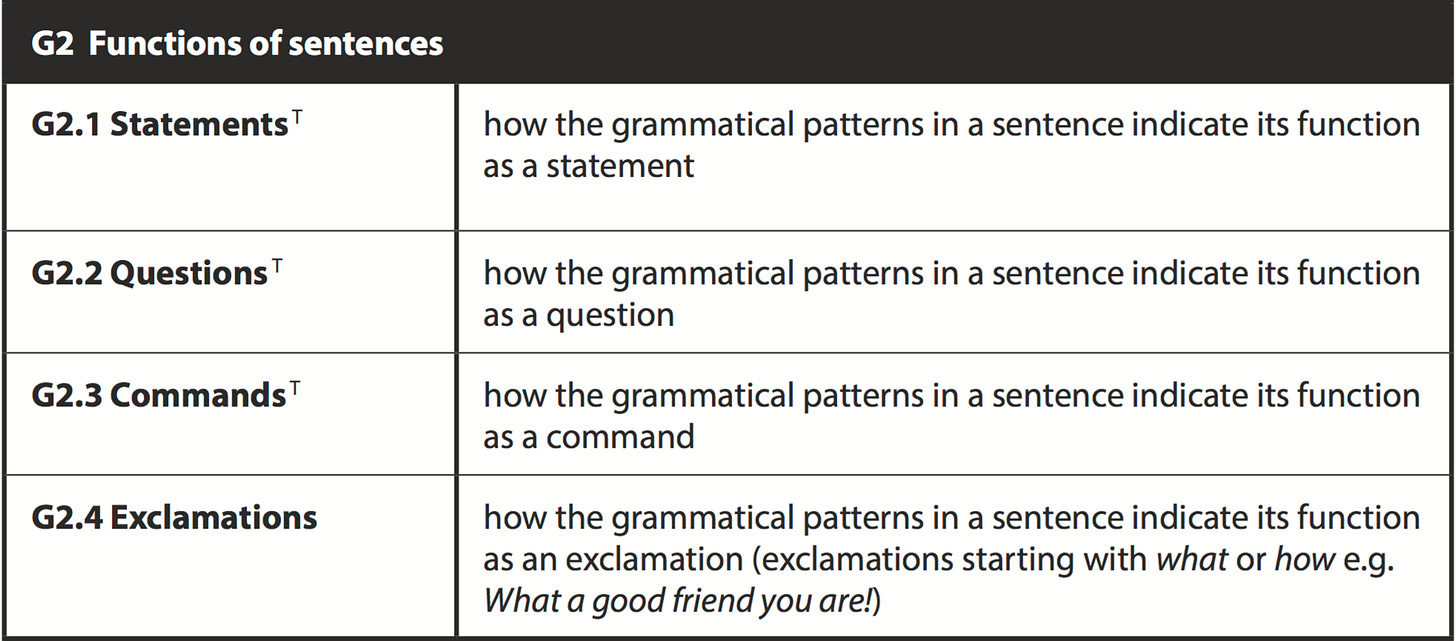There has been a bit of a kerfuffle in the UK press over how the notion of exclamation should be taught to primary school children. Several newspapers have been saying that the guidance published by the Department for Education (DfE) is too hard, and that it is nonsensical or even Orwellian. I am not a spokesman for the DfE, and it's not my job to defend government policy, but since the KS1 test is a reality I thought it would be useful for teachers if I made a few things clear about exclamations.
So what is the fuss about?
The DfE published guidance last year about how the terms statement, question, command and exclamation should be understood in the National Curriculum:

We find some further guidance and some examples in the National Curriculum Glossary:
The form of a sentence’s main clause shows whether it is being used as a statement, a question, a command or an exclamation.
You are my friend. [statement]
Are you my friend? [question]
Be my friend! [command]
What a good friend you are! [exclamation]
It's important to be clear that 'statement', 'question', 'command' and 'exclamation' are defined as sentence patterns which means that they are defined grammatically.
A statement is defined as having a structure in which there is typically a Subject, followed by a verb and then a further unit such as a Direct Object. For example, Jimmy loves his dog, The government will make an announcement at noon, She reads two newspapers every day, etc.
Questions can have two patterns. Some can have 'yes' or 'no' as an answer. For example, Do you like Paris?, Can you speak Russian? Will you marry me?, etc. Alternatively, they have a pattern that asks an 'open' question which can have any number of answers, e.g. What did you have for breakfast?, Which newspaper do you read?, Who is your favourite actor?, etc.
Commands also have a special structure in that they typically lack a Subject. Examples are: Eat your dinner, Be quiet, Open the door, etc.
Exclamations grammatically have a structure that involves the words what a or how, as in What a nice person you are! What a beautiful painting!, How clever you are!, How wonderful that is! (Notice that the Subject goes before the verb in How clever you are! If this were a question we would have How clever are you?)
The DfE marking guidance notes say:
This is causing confusion, but it needn't. Let's look at some examples.
If someone writes He is a great story teller! or I love scary movies! then these sentences conform to the grammatical pattern for statement, so they are not technically exclamations, despite the fact that they are used to exclaim something, and have an exclamation mark at the end. I don't think that in the DfE guidance there is an implication that exclamation marks should not be used here; it's just that these sentences are not exclamations, defined as grammatical patterns.
What about this example: How do you travel to work? Is this an exclamation? The answer is 'no'. It's grammatically a question, despite the use of the word how.
Should kids know about this at KS1? The short answer is 'yes', because it is part of the National Curriculum, and hence part of the new KS 1 test in May 2016. However, those who say that it's perhaps too early to teach children aged 5-7 this kind of thing have a point.
Incidentally, you might be interested to know that sometimes we have a mismatch between the structure of a sentence, and how it is used. If I say to you at dinner Can you pass me the salt? then this is technically a question that has 'yes' or 'no' as possible answers, but in fact the pattern is used here to tell you to do something. It's because of these possible mismatches that linguists prefer to use two sets of terms to describe the phenomena above. For the sentence patterns they use declarative, interrogative, imperative and exclamative. Corresponding to this are statement, question, command and exclamation to describe how these patterns are used. The National Curriculum has conflated the two sets into one.




